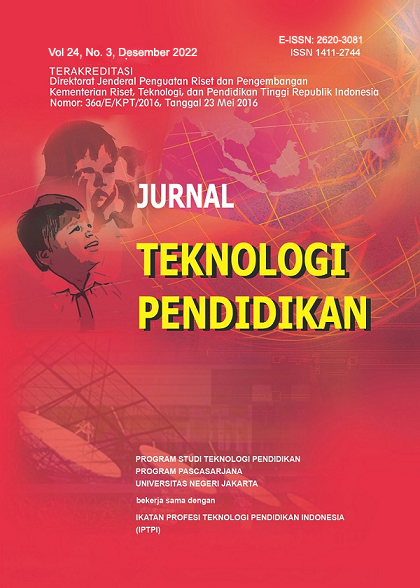Development of Canva Application Assisted Learning Media in Class XII Advanced Study Materials with 4-D Models
DOI:
https://doi.org/10.21009/jtp.v24i3.30483Keywords:
Learning Media, Canva, 4-D ModelAbstract
This study aims to share learning media using Canva and to find out student responses. This type of research is research using the 4-D development example developed by S. Thiagarajan using 4 stages, namely: the definition stage (Define), the planning stage (Design), the development stage (Develop), the dissemination stage (Disseminate). The research sample was class XII students totaling 38 students. Research instruments include questionnaires and needs analysis in this study using observation, interviews and questionnaires. The technique used in the analysis of this research data is quantitative descriptive analysis. Learning media using Canva can increase student learning motivation. The use of this media is very effective, both offline and online. The development of Canva learning media is also based on phenomena in the field, namely that there has not been development of learning media using Canva for use at MAN 1 Pontianak, as a result it is necessary to develop learning media using Canva that are valid and practical. The purpose of this study is to share learning media using Canva which is used at MAN 1 Pontianak. It is hoped that this learning media can be used by teachers, especially guidance and counseling teachers for learning in advanced study material classes.
References
Akhmadan, W. (2017). Development of Teaching Materials on Lines and Angles Using Macromedia Flash and Moodle for Grade VII Junior High Schools. Gantang Journal, 2(1), 27-40.
Canva. 2020. “Canva for Education - Free Graphic Design Tool for Schools”, Canva for education, https://www.canva.com/educatio.
Fajri, K., & Taufiqurrahman, T. (2017). Development of Textbooks Using the 4D Model in Increasing the Success of Islamic Religious Education Learning. Journal of Indonesian Islamic Education, 2(1), 1–15. https://doi.org/10.35316/jpii.v2i1.56.
Hapsari, G. P. P., & Zulherman. (2021). Development of Canva Application-Based Animated Video Media to Increase Student Motivation and Achievement. Basicedu Journal, 5(4), 2384–2394. Retrieved from https://basic.org/index.php/basicdu/articles/views/123.
Kartika, L. (2020). Development of Information Services Media for Further Studies Based on Multimedia Flip E-Books for High School Students. Journal of Islamic Education Counseling, 1(1), 27–40. https://doi.org/10.32806/jkpi.v1i1.5
Komara, A. L., Pamungkas, A. S., & Dewi, R. S. (2022). Development of Cartoon-Animated Video-Based Learning Media in Elementary Schools. Primary: Journal of Elementary School Teacher Education, 11(2), 316. https://doi.org/10.33578/jpfkip.v11i2.8585.
Lestari, N. (2018). The procedural adopts the 4D model from Thiagarajan, a biotechnology MFI development study using the PBL model for students. FST Undana Scientific Journal of Technology, 12(2), 18–23. Retrieved from https:/ /ejurnal. undana.ac.id/Mahardika, A. I., Wiranda, N., & Pramita,
Mahardika, A. I., Wiranda, N., & Pramita, M, Making interesting learning media using Canva to optimize online learning, Journal of Education and Community Service, 4(3), 2021.
Nababan, N. (2020). Pengembangan Media Pembelajaran Berbasis Geogebra Dengan Model Pengembangan Addie Di Kelas Xi Sman 3 Medan. Inspiratif: Jurnal Pendidikan Matematika, 6(1).
Nurrita, T. (2018). Development of learning media to improve student learning outcomes. MISYKAT: Journal of Al-Quran, Hadith, Shari'ah and Tarbiyah Sciences, 3(1), 171.
Pelangi, G. (2020). Utilization of the Canva application as a medium for learning Indonesian language and literature at the SMA/MA level. Unpam Sasindo Journal, 8(2), 79-96.
Rahmatullah, R., Inanna, I., & Ampa, A. T. (2020). Audio-visual learning media based on the Canva application. Undiksha Journal of Economic Education, 12(2), 317-327.
Rajagukguk, K. P., Renni, R., Jihan, K., & Novi, S. (2021). 4D Model Learning Media Development Training for Elementary School Teachers.
Rosyidah, N., Hidayat, J.N., & Azizah, L.F. (2019). Uriscrap Media Feasibility Test (Uri Scrapbook) Using the 4D Development Model. LENS (Science Lantern): Journal of Science Education, 9(1), 1–7. https://doi.org/10.24929/lensa.v1i1.43
R.S. A.H, Cahyadi, Development of Teaching Materials, Halaqa: Islamic Education Journal, 3(1), 35-42, 2019.
Sakti, I., Idamayanti, R., & Agussalim. (2022). Development of Learning Media Using Canva in Basic Physics Courses. Journal of Physics Education and Applied Physics, 3(2).
Siti Nurhalisa, S. (2022). Pengembangan Media Interaktif Berbantuan Canva Pada Pembelajaran IPA Dengan Pendekatan Saintifik. Ability: Journal of Education and Social Analysis, 37-45.
Tanjung, Rahma Elvira, and Delsina Faiza. "Canva as a learning medium in basic electricity and electronics subjects." Voteteknika (Vocational Electronics and Informatics Engineering) 7.2 (2019): 79-85.
Yuniati, E., Pratikto, H., & Sopiah, S, Motivation Of Women'S Entrepreneurship As Agent Of Change In Society: Literature Review,International Journal of Economics, Business and Accounting Research (IJEBAR), 5(4), 2021.
Downloads
Published
How to Cite
Issue
Section
License
Jurnal Teknologi Pendidikan is an Open Access Journal. The authors who publish the manuscript in Jurnal Teknologi Pendidikan agree to the following terms.
Attribution-ShareAlike 4.0 International (CC BY-SA 4.0)
-
Attribution — You must give appropriate credit, provide a link to the license, and indicate if changes were made. You may do so in any reasonable manner, but not in any way that suggests the licensor endorses you or your use.
-
ShareAlike — If you remix, transform, or build upon the material, you must distribute your contributions under the same license as the original.
- No additional restrictions — You may not apply legal terms or technological measures that legally restrict others from doing anything the license permits.
Notices:
- You do not have to comply with the license for elements of the material in the public domain or where your use is permitted by an applicable exception or limitation.
- No warranties are given. The license may not give you all of the permissions necessary for your intended use. For example, other rights such as publicity, privacy, or moral rights may limit how you use the material.








